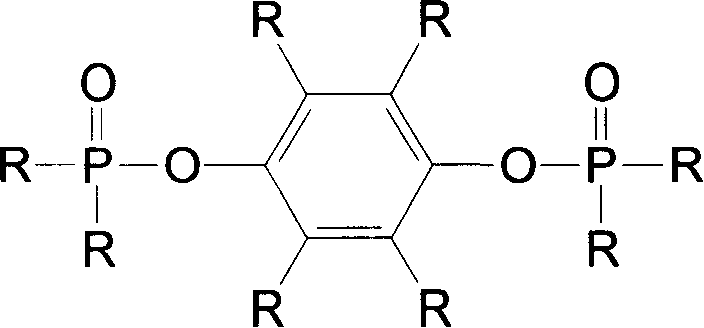Synthesis process of phosphoric phenolic resin
A phosphoric acid phenolic resin and a synthesis process technology, applied in the field of the synthesis process of phosphoric acid phenolic resin, can solve the problems of gap, unsatisfactory heat resistance and the like
- Summary
- Abstract
- Description
- Claims
- Application Information
AI Technical Summary
Problems solved by technology
Method used
Image
Examples
example 1
[0012] Example 1: drop into 282g of phenol, 115g of 85% phosphoric acid in the there-necked flask equipped with cooling reflux, stirring and thermometer devices, add the catalyst and be warming up to 60°C of temperature, tap water cooling and reflux, react for 3 hours, and the reaction temperature is cooled to room temperature, 120g of paraformaldehyde was added, another catalyst was added, and the temperature was raised to 90°C for 1 hour of reaction. Then vacuumize to make the vacuum degree reach 300-650mmHg, so that the reactants can remove low molecular weight substances, hold for 0.5-1 hour, and discharge when the gel degree reaches 80-150s / 160±1°C, and phosphoric acid can be obtained Phenolic Resin.
example 2
[0013] Example 2: drop into phenol 282g, 85% phosphoric acid 115g in the there-necked flask equipped with cooling reflux, stirring and thermometer device, after adding catalyst, be warming up to temperature 60 ℃, tap water cooling reflux, react 3 hours, the reaction temperature is cooled to room temperature, 120g of paraformaldehyde was added, another catalyst was added, and the temperature was raised to 90°C for 5 hours of reaction. Then vacuumize to make the vacuum degree reach 300-650mmHg, so that the reactants can remove low molecular weight substances, hold for 0.5-1 hour, and discharge when the gel degree reaches 80-150s / 160±1°C, and phosphoric acid can be obtained Phenolic Resin.
example 3
[0014] Example 3: drop into 282g of phenol, 115g of 85% phosphoric acid in the there-necked flask equipped with cooling reflux, stirring and thermometer device, add the catalyst and be warming up to 60°C of temperature, tap water cooling and reflux, react for 3 hours, and the reaction temperature is cooled to room temperature, 120g of paraformaldehyde was added, another catalyst was added, and the temperature was raised to 140°C for 1 hour of reaction. Then vacuumize to make the vacuum degree reach 300-650mmHg, so that the reactants can remove low molecular weight substances, hold for 0.5-1 hour, and discharge when the gel degree reaches 80-150s / 160±1°C, and phosphoric acid can be obtained Phenolic Resin.
PUM
| Property | Measurement | Unit |
|---|---|---|
| decomposition temperature | aaaaa | aaaaa |
Abstract
Description
Claims
Application Information
 Login to view more
Login to view more - R&D Engineer
- R&D Manager
- IP Professional
- Industry Leading Data Capabilities
- Powerful AI technology
- Patent DNA Extraction
Browse by: Latest US Patents, China's latest patents, Technical Efficacy Thesaurus, Application Domain, Technology Topic.
© 2024 PatSnap. All rights reserved.Legal|Privacy policy|Modern Slavery Act Transparency Statement|Sitemap


